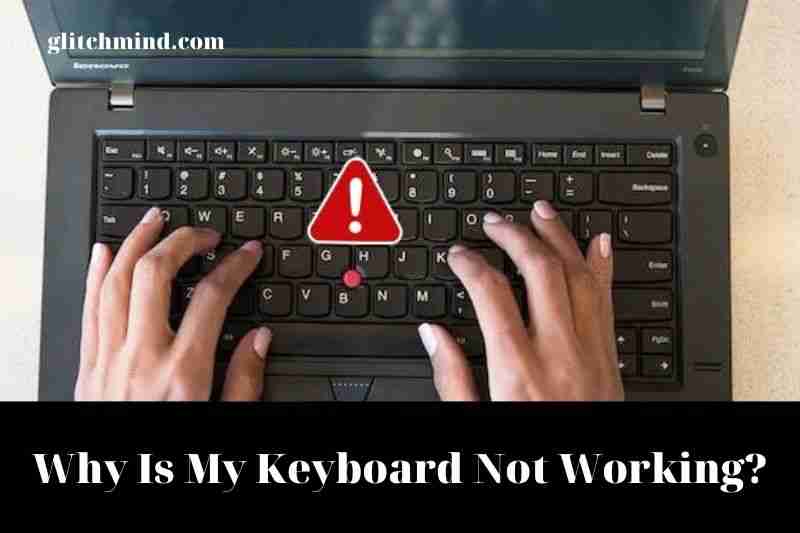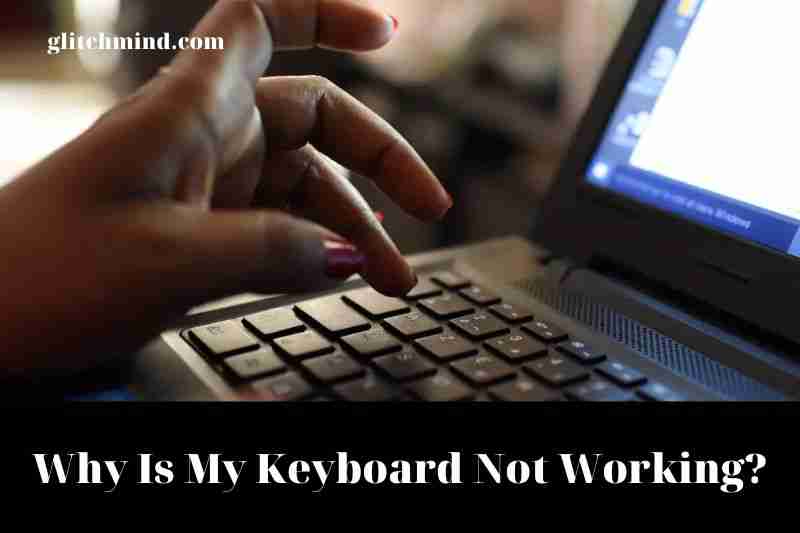Why is my keyboard not working? There are several possible reasons why your keyboard is not working. It could be a hardware issue, such as a loose connection or a problem with the keyboard itself.
Alternatively, it could be a software issue, such as a driver problem or a conflict with another program. If you’re not sure what the problem is, try troubleshooting your keyboard to see if you can identify the root cause.
Why is my keyboard not working?
There are many reasons why you might be experiencing issues with your keyboard, ranging from software problems to hardware problems. Most times, you can pinpoint the issue to the most frequent laptop repair issues, for example:
1. The Driver
Your keyboard might respond after a driver problem. If you’ve used a different keyboard, the driver might be interfering, causing the keyboard to stop working.
2. The Motherboard
A ribbon or connector that connects your keyboard and laptop’s motherboard might have become damaged, loose or broken, which causes your keyboard not to respond.
3. Hidden Dirt And Spills
Do you need help remembering the last time when you washed your keyboard? There may be dirt on or around specific keys, causing them to become stuck, jam or cease functioning.
4. Sensitivity Settings
If you press a key once and it is displayed on your screen multiple times, your settings may need to be correctly updated or altered, resulting in multiple entries for each key press.

8 Hacks to Try if Your Laptop Keyboard Has Stopped Working
There are many reasons why laptop keyboards may cease to function. Whatever the reason, however, we’re here to help. Use some of our hacks below so that your laptop will function within a matter of minutes.
1. Reboot Your Computer
The most popular advice you’ll get when facing any computer issue suggests giving a reboot a go. It’s not a surprise since rebooting your computer brings it back to its original state, free of problems. Therefore, go ahead and restart your PC. A simple restart should restore everything to normal.
2. Verify if the Problem Is Caused by Hardware or Software
There are two possibilities for your external keyboard becoming stuck or unable to move: either your hardware is failing, or there are glitches in the software.
Start by rebooting your computer, then go into BIOS or UEFI. For older Windows systems, you can enter into BIOS using F1, F2, Esc, Del, or any other.
However, on the newer machines, i.e., systems manufactured in the last few years, you’ll have to use a different method as the booting speed is too fast, making entering BIOS difficult–especially if you have Windows 10 fast boot enabled.
When keyboard works with newer machines:
- Open the search bar in the Start menu and type in “settings” to choose the most suitable batch.
- From the menu Settings, choose Update and Security, then Recovery.
- Now, under the Advanced Startup option, Click on Restart now.
- In the next menu, choose Troubleshoot > Advanced options UEFI Firmware Settings (choose the Startup Settings If you don’t see that option).
If you’re running Windows 11, restarting in the same manner as above is slightly different. Instead of Update and Security, select System > Recovery. Then, click Restart now.
Suppose your PC is restarted. Press the key F1 (or F2) to open the BIOS. Click Restart once you are prepared. Your system will be opened within BIOS as well as UEFI. No matter which method you choose, if your computer successfully starts up in BIOS and UEFI configurations, then your computer’s hardware will likely be in good condition.
3. Update keyboard drivers or Uninstall the Laptop Keyboard Drivers
Another option to address laptop keyboards that don’t function is to upgrade the driver. Here’s how.
In the Start menu’s Search bar, type “device manager” and select the most appropriate match.
Explore through the devices’ list until you find Keyboards. If you spot it, click this to increase the options.
Right-click on the keyboard device, choose the Properties tab, and then the driver.
Click Update Driver. Wait while Windows detects the driver that is new to install it. Try the keyboard using Word processors or using the Windows Notepad app. With any luck, you’ll be able to use it.
If none of this working keyboard, Try driver removal. You can locate the driver for the keyboard inside the Device Manager. If you notice an exclamation point in yellow, it’s a clear driver issue. Reinstallation can be recommended even when you don’t have a problem.
Right-click the driver of the keyboard and then select Properties.
In the driver tab, choose to Uninstall device.
Then restart your computer, and Windows will download the most recent driver and install it on your behalf. If the driver’s corruption was responsible for your keyboard’s crash, then the driver reinstall will fix it.

4. Is the Laptop Keyboard Not Working? Clean It!
Cleaning a standard keyboard is challenging; cleaning laptop keyboards is even more difficult. Keyboards require some physical interaction to help loosen dirt. Although this is usually easy to accomplish with a USB port or wireless keyboard, things are different with laptops.
In essence, it is impossible to move and tap the laptop’s back without risking injury to the entire device.
You can clean dirt and dust from laptop keyboards by shutting them down before flipping them upside-down and gently tapping the bottom. Moving your fingers over all keys while the device is upside down is advisable.
Make sure to clean all dirt on the table once you’re finished. If there’s dirt that you can’t get rid of, then you could use compressed air for this moment or rely on some keyboard cleaner putty instead.
It is important to note that cleaning can’t fix the deep-seated issues, but it can help if dirt blocks some keys from functioning effectively. Check out our complete guide on cleaning your keyboard for a more thorough approach.
5. Replace a Faulty Laptop Keyboard
If your keypad is damaged or disconnected from the motherboard, perhaps because of a shock, you’ll have to set some time to take off the keyboard from your laptop or reconnect or even replace the keyboard altogether.
Different laptop makers build laptops differently, so it’s hard to pinpoint one fix.
However, it is possible to open different laptops of the same manufacturer that are generally identical. This makes switching keys (or simply replacing cables) significantly more straightforward.
It is essential to note Laptop keyboards are usually sealed, and although it’s possible to give them an improved clean after removing them from the computer system, you will not be able to examine the internal operation of the keyboard.
When a keyboard is removed, it is possible to verify the serial number. You can enter this number into the search bar on eBay to check if the item is available for purchase. It is usually, but replacing a laptop keyboard is costly.
6. What if a Specific Keyboard Keys Doesn’t Work?
Are you having trouble using having trouble with the “@” key? Are you unable to achieve a Shift into working?
If you’re experiencing difficulties only with certain keyboard buttons, it may be related to your setting for your language. If you’ve found out that the issue isn’t due to hardware-related, it’s the first thing you need to look into.
Open a text editor, and hit the key you want to. Do you see any output? If it’s a wrong symbol, The issue is most likely due to the setting up of the language. Different regions employ different keyboard layout depending on how the characters are utilized.
You’ll have to change your regional settings to align with your keyboard.
For Windows 10, you do this by pressing Windows Key + I and selecting Time and Language > Language.
Select Add a Language and select the proper selection for your keyboard.
Click Next > Install, and then take a few seconds until it is installing the language. In the Region and Language screen, click on the Language dropdown menu to choose the language you want to add.
Make sure you check your keyboard input, and the correct characters should now be output onto the screen.

7. Check the Keyboard Settings
You may be experiencing an issue with your keyboard. Various reasons could cause this, but it most commonly occurs when you’ve installed a brand-new app on your computer.
Alternatively:
- Enter ease of access into the Start menu’s search bar and then choose Ease of Access in the keyboard settings.
- Then, verify to see if the Use Filter keys are turned on. If they are, turn off the feature and check whether the issue persists.
8. Run an SFC Scan
SFC is a free program that will help you repair corruption issues in Windows System files. To determine (and repair) the cause of the keyboard’s slowdown can be attributed to these:
Click on the search bar in the Start menu and type in “cmd” then select Run with administrator.
When you’re in the Command Prompt, type in “SFC /scan now” and then press Enter.
The SFC will quickly scan your entire system files for any signs of corruption. Then, it will try to fix any issues it detects in the files. Once the scan is completed, you’ll need to restart your computer to reflect the changes.
Can You Fix a Defective Laptop Keyboard?
I hope that some of the solutions will fix your laptop’s keyboard. Don’t be discouraged even if they did not. When your device is covered under warranty, or you are aware of a trusted repair shop, You should be able to repair the device at a minimum cost.
In the meantime, you can also use Bluetooth, as a USB keyboard can replace a keyboard for a short period, or you could use Windows 10’s on-screen keyboard. Windows 10 on-screen keyboard.
Read also:
